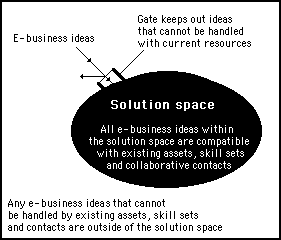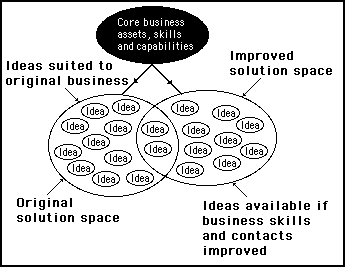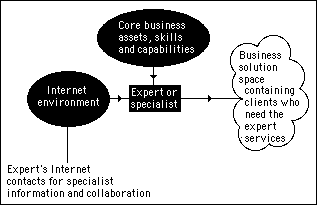
Chapter 7
Boundaries of the solution space
A dynamic, bottom up solution space
In the last chapter, it was proposed that rather than starting out with an initial idea, it might be better to begin by building a core strength and a number of useful contacts. In this way business ideas can be preferentially selected to match the capabilities of the business (as opposed to creating a business to match any business ideas).
This strategy can be described in terms of a dynamic solution space, where the solution space is the catchment area for all ideas that can be managed by the system of assets, skill sets and potential collaborative associations that together constitute the capabilities of an individual or a business. This is illustrated in figure 7.3.

Figure 7.3
A dynamic, bottom up solution space that includes only those ideas that are compatible with a existing assets, skill sets and contacts
The solution space is thus defined as a selection of business ideas that can adequately be handled by the core strengths that have been developed by the business (the core strengths being enhanced through having a number of trusted contacts who can be called upon to advise, assist or form collaborative alliances).
To appreciate the dynamics of this model, think of the ideas in the solution space as being observed under a magnifying glass. Adding extra assets, skill sets or useful contacts to a business will have the effect of moving the magnifying glass over to another group of ideas which are more appropriately suited. This is illustrated in figure 7.4.

Figure 7.4
By improving the assets, skills or contacts, the solution space will effectively move to include a different set of business ideas that can be accommodated
In this way, it can be seen that business ideas are a dynamic consequence of the structure and components of the business. This is quite different from a top down approach, where once an idea is decided upon it becomes the basis for reshaping the business to accommodate the idea.
This strategy, of creating the core strengths before coming up with an idea, is not intuitive. When Wendi Murray, an entrepreneur from Australia, read the last chapter in the virtual cafe she responded:
In chapter 5 Peter wrote:
"A business idea has the best chance of being brought to fruition if it is born into the right environment (where a suitable infrastructure and the necessary contacts are in place). Surely then, it would make sense to wait until these conditions are in existence before firming up or going ahead with any specific e-business idea?"
Although I agree with this, it implies that the 'right environment' is known and so the 'suitable infrastructure' _can_ be in place. Surely a preexisting environment and infrastructure will limit the kinds of ideas to be considered, so again, a top-down weeding-out of environment / infrastructure ideas is needed?
Wendi
This illustrates where a conceptual difficulty can occur because it is natural to assume that a "right environment" or a "suitable infrastructure" is planned for a particular purpose. But, the whole point of a bottom up approach is that the future is not anticipated so it cannot be planned for or taken into account.
The environment and the infrastructure are created without any specific business idea in mind. They are created in the same way that people get themselves educated: there is no specific application in mind, just the accumulation of various contacts, knowledge and experiences that create a favourable position to be in to be able to take an opportunity when it arises.
If you ask a student what job they are going to get when they finish their education they are unlikely to be able to give a definite answer. They are just building up a favourable position for themselves, so as to more easily be able to be accepted by a company when a suitable job opportunity arises. This is exactly the same strategy that is needed for the volatile environment of the Web: build an asset base; a skill set; a personal (or local) knowledge base; a set of useful contacts - and then go search for a suitable opportunity that is suited to this mix.
This strategy will create a filter, which will rule out many possible options, but, doesn't the choice of education do exactly the same thing? Doesn't a particular choice of education or set of experience act as a filter to direct you towards a limited selection of options? Doesn't an increased education, or a richer set of work experiences, open the door to better opportunities? Looked at in this way, it makes a lot of sense to spend time building up a strong position first before looking for ideas.
The concept is clearer if you consider the business strategy of a typical niche specialist who might decide to concentrate upon a particular small area of specialty. The specialist will need to build up this expertise before taking on any substantial assignments. The area of expertise chosen will limit the type of assignments that can be taken. Their solution space might then be defined as consisting of all the businesses that would have need of the specialty service they are capable of handling. This scenario is illustrated in figure 7.5.

Figure 7.5
A typical special service company whose business solutions could be described as a space containing all the clients who would have need of their services. Improve the expertise or ability to collaborate and the content of this solution space will improve.